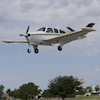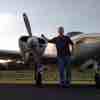02 May 2025, 02:07 [ UTC - 5; DST ]
|

| Username Protected |
Message |
|
Username Protected
|
Post subject: Re: Raptor Aircraft 5 Seat Pressurized 3,600 NM Range Die  Posted: Posted: 12 May 2016, 22:32 |
|
 |

|
|
 |


Joined: 08/10/14
Posts: 1781
Post Likes: +864
Location: Northwest Arkansas (KVBT)
Aircraft: TBM850
|
|
Username Protected wrote: The could get some gains with a really clean airframe, but 300kts... no way, and yes, 200 would be an accomplishment.
Heck if the performance were half, and the price doubles, it would still be a bargain. I'm not optimistic. With a turbo that (per their plans) delivers close to full rated horsepower at FL250 you don't think that greater than 135kias is possible? A Cirrus can do close to 150kias there according to the specs. I don't mean to say that I think this will be a 300ktas plane, but thinking about what might be reasonable it seems that 200 is pretty conservative. Though I don't know much about the experimental world, it seems that automotive engines are not a popular choice. Is that right, and if so, what are the drawbacks?
|
|
| Top |
|
|
Username Protected
|
Post subject: Re: Raptor Aircraft 5 Seat Pressurized 3,600 NM Range Die  Posted: Posted: 12 May 2016, 22:43 |
|
 |

|
|


Joined: 12/03/14
Posts: 19926
Post Likes: +25000
Company: Ciholas, Inc
Location: KEHR
Aircraft: C560V
|
|
Username Protected wrote: With a turbo that (per their plans) delivers close to full rated horsepower at FL250 you don't think that greater than 135kias is possible? With good design, yes. 135 KIAS at FL250 is about 200 KTAS. It takes a lot more power to indicate 135 KIAS at FL250 than it does at 0 MSL. Quote: Though I don't know much about the experimental world, it seems that automotive engines are not a popular choice. Is that right, and if so, what are the drawbacks? The automotive engine is designed for highly variable power output, smooth operation at various power, and not for continuous high power operation. A car typically cruises at less than 20% max power. Mike C.
_________________
Email mikec (at) ciholas.com
|
|
| Top |
|
|
Username Protected
|
Post subject: Re: Raptor Aircraft 5 Seat Pressurized 3,600 NM Range Die  Posted: Posted: 12 May 2016, 22:58 |
|
 |

|
|
 |


Joined: 08/10/14
Posts: 1781
Post Likes: +864
Location: Northwest Arkansas (KVBT)
Aircraft: TBM850
|
|
Username Protected wrote: The automotive engine is designed for highly variable power output, smooth operation at various power, and not for continuous high power operation. A car typically cruises at less than 20% max power.
Mike C. Would an automotive diesel power plant handle continuous high power loads better than a gas engine? Thinking about industrial applications like generators where load is continuous... And regarding requiring more power at FL250 than at 0msl to achieve the same indicated airspeed, is the difference propeller efficiency or something else?
|
|
| Top |
|
|
Username Protected
|
Post subject: Re: Raptor Aircraft 5 Seat Pressurized 3,600 NM Range Die  Posted: Posted: 12 May 2016, 23:05 |
|
 |

|
|
 |

Joined: 08/26/15
Posts: 9917
Post Likes: +9803
Company: airlines (*CRJ,A320)
Location: Florida panhandle
Aircraft: Travel Air,T-6B,etc*
|
|
Username Protected wrote: And regarding requiring more power at FL250 than at 0msl to achieve the same indicated airspeed, is the difference propeller efficiency or something else? Propeller efficiency can have a bit to do with it but it's mostly because of true airspeed. power = thrust x true airspeed thrust is fairly constant for a given indicated airspeed at different altitudes
|
|
| Top |
|
|
Username Protected
|
Post subject: Re: Raptor Aircraft 5 Seat Pressurized 3,600 NM Range Die  Posted: Posted: 12 May 2016, 23:11 |
|
 |

|
|


Joined: 12/03/14
Posts: 19926
Post Likes: +25000
Company: Ciholas, Inc
Location: KEHR
Aircraft: C560V
|
|
Username Protected wrote: Would an automotive diesel power plant handle continuous high power loads better than a gas engine? It has to do with part throttle optimizations and designing for intermittent duty. The history of automotive conversions for aircraft use is not good. Quote: Thinking about industrial applications like generators where load is continuous... They are usually very heavy engines that turn slowly. Very low power to weight ratios. Easy to make that last a long time. Quote: And regarding requiring more power at FL250 than at 0msl to achieve the same indicated airspeed, is the difference propeller efficiency or something else? Let's say the thrust you need for 135 KIAS is that same at 0 MSL and FL250. The distance the prop generates that thrust in an hour is 135 nm at 0 MSL and 200 nm at FL250. Same force through more distance is more power. Further, the faster true airspeed means higher prop blade angle. As the angle increases, the thrust vector forward is the cosine of the blade angle, so it reduces as well. Net effect, it takes considerably more power to fly same indicated airspeed up high, in this case about 50% more power to go from 0 MSL to FL250. Mike C.
_________________
Email mikec (at) ciholas.com
|
|
| Top |
|
|
Username Protected
|
Post subject: Re: Raptor Aircraft 5 Seat Pressurized 3,600 NM Range Die  Posted: Posted: 12 May 2016, 23:26 |
|
 |

|
|
 |


Joined: 08/10/14
Posts: 1781
Post Likes: +864
Location: Northwest Arkansas (KVBT)
Aircraft: TBM850
|
|
Another area of skepticism for me on this project is the price/parts list: http://www.raptor-aircraft.com/ordering.htmlThis list includes 62 parts. Obviously many of them are assemblies or collections of parts, but it still seems radically simple relative to any other high performance aircraft. What are they missing? The pricing for individual parts/assemblies they do list seems reasonable to me. Whether there is $46k of markup in those parts that they can shave off is questionable.
|
|
| Top |
|
|
Username Protected
|
Post subject: Re: Raptor Aircraft 5 Seat Pressurized 3,600 NM Range Die  Posted: Posted: 12 May 2016, 23:36 |
|
 |

|
|
 |


Joined: 08/10/14
Posts: 1781
Post Likes: +864
Location: Northwest Arkansas (KVBT)
Aircraft: TBM850
|
|
Also, I found a longer version of their "story" on an old Indiegogo project https://www.indiegogo.com/projects/rapt ... aircraft#/ Gives you an idea of what parts of his plan have changed and what has stayed the same since their early design stage (that version used a turbine). Kit price excluding the engine, avionics, paint and interior at that point was $80k. $190k for a finished piston version.
|
|
| Top |
|
|
Username Protected
|
Post subject: Re: Raptor Aircraft 5 Seat Pressurized 3,600 NM Range Die  Posted: Posted: 12 May 2016, 23:40 |
|
 |

|


|
 |

Joined: 12/10/07
Posts: 34620
Post Likes: +13249
Location: Minneapolis, MN (KFCM)
Aircraft: 1970 Baron B55
|
|
Username Protected wrote: it seems to be progressing nicely Yes, the marketing is coming along nicely. I'm not sure what universe they plan to build it in, the numbers they give certainly aren't from ours. Mike C.
230 KTAS on 7gph? Maybe in a steep descent.
And the price would only make sense if they can build the fuselage and wings for almost nothing (seems unlikely for a pressurized carbon fiber design) as the cost of just the engine, prop, and avionics will likely exceed the offered price.
And wouldn't a pressurized 200+ Kt cruiser need a known ice package? That itself would add another $50 at a minimum.
_________________
-lance
It's easier to fool people than to convince them that they have been fooled.
|
|
| Top |
|
|
Username Protected
|
Post subject: Re: Raptor Aircraft 5 Seat Pressurized 3,600 NM Range Die  Posted: Posted: 13 May 2016, 10:30 |
|
 |

|
|


Joined: 12/03/14
Posts: 19926
Post Likes: +25000
Company: Ciholas, Inc
Location: KEHR
Aircraft: C560V
|
|
One example of the insanity: 11 GPH making 300 HP is 0.246 lbs/hp/hr specific fuel consumption. World record for a 4 stroke diesel is 0.271 lbs/hp/hr. http://www.gizmag.com/wartsila-31-world ... ine/38120/That's a marine engine that makes 13,000 HP, 25 ft long, and weighs 85 tons. (It also has a 32,000 hour TBO!) Mike C.
_________________
Email mikec (at) ciholas.com
|
|
| Top |
|
|
Username Protected
|
Post subject: Re: Raptor Aircraft 5 Seat Pressurized 3,600 NM Range Die  Posted: Posted: 13 May 2016, 10:36 |
|
 |

|

|
 |


Joined: 10/26/08
Posts: 4627
Post Likes: +1031
Location: Pinehurst, NC (KSOP)
Aircraft: 1965 Bonanza S35
|
|
Username Protected wrote: One example of the insanity: 11 GPH making 300 HP is 0.246 lbs/hp/hr specific fuel consumption. World record for a 4 stroke diesel is 0.271 lbs/hp/hr. http://www.gizmag.com/wartsila-31-world ... ine/38120/That's a marine engine that makes 13,000 HP, 25 ft long, and weighs 85 tons. (It also has a 32,000 hour TBO!) Mike C. Hmmm? I read... "A high speed cruise using about 230hp will get you about 190 kias or 285 ktas burning about 11gph resulting in about 29mpg. If you throttle back to 150hp you will see about 155 kias or 232 ktas on about 7 gph resulting in about 38mpg. "http://raptor-aircraft.com/engine.html
_________________
dino
"TRUTH is AUTHORITY..... Authority is not Truth"
|
|
| Top |
|
|
Username Protected
|
Post subject: Re: Raptor Aircraft 5 Seat Pressurized 3,600 NM Range Die  Posted: Posted: 13 May 2016, 10:57 |
|
 |

|

|
 |

Joined: 11/18/09
Posts: 1259
Post Likes: +387
Location: Lake Havasu City, AZ (KHII)
Aircraft: 1979 Bonanza V35B
|
|
Username Protected wrote: Am I the only one that think canards look ridiculous unless its a starship or the wright flyer? Yes!  ( LongEZ builder and flyer)
Please login or Register for a free account via the link in the red bar above to download files.
|
|
| Top |
|

|
You cannot post new topics in this forum
You cannot reply to topics in this forum
You cannot edit your posts in this forum
You cannot delete your posts in this forum
You cannot post attachments in this forum
|

Terms of Service | Forum FAQ | Contact Us
BeechTalk, LLC is the quintessential Beechcraft Owners & Pilots Group providing a
forum for the discussion of technical, practical, and entertaining issues relating to all Beech aircraft. These include
the Bonanza (both V-tail and straight-tail models), Baron, Debonair, Duke, Twin Bonanza, King Air, Sierra, Skipper, Sport, Sundowner,
Musketeer, Travel Air, Starship, Queen Air, BeechJet, and Premier lines of airplanes, turboprops, and turbojets.
BeechTalk, LLC is not affiliated or endorsed by the Beechcraft Corporation, its subsidiaries, or affiliates.
Beechcraft™, King Air™, and Travel Air™ are the registered trademarks of the Beechcraft Corporation.
Copyright© BeechTalk, LLC 2007-2025
|
|
|
|



